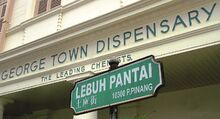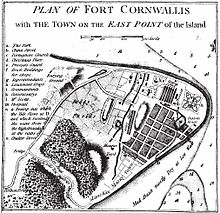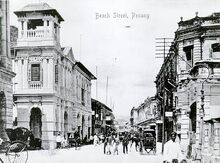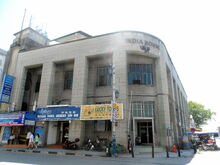
Beach Street is one of the first streets of George Town and has been serving as the commercial centre of the city. Pictured here is the Standard Chartered Bank Building.
Beach Street, within George Town UNESCO World Heritage Site, is one of the first streets of George Town and has been the city's commercial centre. The street, which runs north to south near the eastern coast of the George Town promontory, was laid out between 1786 and 1787. Together with Light Street, Pitt Street and Chulia Street, Beach Street marked the earliest limits of George Town.
Whilst initially, the piers along Beach Street allowed vessels to dock and unload their cargo, land reclamation in the mid-19th. century pushed the coast eastwards. Nonetheless, Beach Street really gained prominence towards the 20th. century, when European banks were set up along the northern part of the street. To this day, Beach Street serves as the commercial and financial heart of George Town.

A bilingual info-marker at Beach Street explaining the history of the street.

A multilingual Beach Street sign. Beach Street is translated into Lebuh Pantai in Malay.
Different architectural styles can be seen along Beach Street, due to the different ethnicities who set up businesses along the same street. While the northern part of Beach Street is dominated by Art Deco- and Neoclassical-styled bank headquarters, Indian architecture is concentrated around the junction with Market Street, which forms part of Little India.
Further to the south is the heart of the Chinese commercial district, where Beach Street abruptly becomes narrower before the Ghee Hiang headquarters. The street terminates at the junction with Prangin Road and Prangin Road Ghaut, next to the former Sia Boey Market ('town's end' in Penang Hokkien). Anson Bridge links this intersection with Bridge Street (now C.Y. Choy Road) across the Prangin Canal.
Every Sunday, the Occupy Beach Street event sees parts of Beach Street, along with the adjoining Bishop Street, Church Street and Church Street Ghaut, being turned into a car-free, pedestrian zone lined with exciting recreational activities.
Etymology[]

The northern sections of Beach Street are shown here (click to zoom).
Beach Street was so named because, in its initial years, it ran parallel to the eastern coast of the promontory where George Town now stands. The northeastern coast near the junction between Beach Street and Light Street used to be a palm-fringed beach, hence the street name.
The Hokkiens who inhabit Penang Island have different names for each section of Beach Street. The stretch between Light Street to the north and China Street was called Ang3 Mor3 Thor3 Kor3 Kay1 (European Commercial Street), while the next section between China Street and Chulia Street was known as Kang3 a1 Khau4 (Harbour Front), due to the piers that used to exist along this stretch before the 19th. century land reclamation. The stretch between Chulia Street and Armenian Street was called Teong3 Kay1 (Middle Street), whereas the next section up to Acheen Street was labelled Tuan1 Lo1 sin4 Kay1 (Tengku Syed Hussain's Street). The section from Acheen Street to Malay Street was known as Phak1 Thik1 Kay1 (Ironmonger's Street) and the southernmost stretch towards Prangin Road was called Sia3 Boey4.
The Malays also used to have their own names for Beach Street. The stretch to the north of Acheen Street was called Jalan Gudang, due to the several godowns within this particular stretch. The remaining southern section was named Hujung Pasir (Sand's End).
History[]

An old map of George Town. Beach Street ran along the eastern coast of the George Town promontory.
After Light Street, Beach Street was laid out between 1786 and 1787, becoming the second thoroughfare to be laid out in George Town. Therefore, Beach Street is older than most cities within the Malay Peninsula, including Singapore and Kuala Lumpur. At the time, Beach Street ran along the eastern coast of the George Town promontory, which explains its more meandering route. On the inland side of Beach Street, stood wooden and attap commercial houses, none of which survives today. The opposite side was either the beach or pockets of mangrove forests.
Piers were constructed along Beach Street to allow ships to dock and unload their cargo. There were also stone steps reaching down into the sea; these steps served as wharves for sampans to berth and were known as 'ghauts', after the ghats of India. Businesses were derived from trading vessels of various origins.

Chinese shophouses were built along the southern part of Beach Street.
Meanwhile, the Chinese began to settle around the junction between Beach Street and China Street. This would later lead to the growth of a Chinese commercial centre around the southern part of Beach Street.
Beach Street, together with Light Street, Pitt Street and Chulia Street, marked the earliest boundaries of George Town.
In the 1870s, land reclamation off Beach Street began, when the owners of properties along Beach Street were issued grants for reclaimed land. A second round of land reclamation was carried out between 1883 and 1889, with the newly reclaimed land also granted to the adjoining landowners at nominal cost. The land reclamations of the 19th. century gradually expanded the coastline eastwards, so that Beach Street no longer runs along the eastern coast of the George Town promontory.

Another old picture of Beach Street
The tin mining boom in the neighbouring Sultanate of Perak in the late 19th. century also brought about a period of economic prosperity in Penang. Tin was shipped to Penang Island to be smelted and then exported out of the Port of Penang. The influx of trade through the port encouraged many Singapore-based mercantile companies to set up branches in George Town, followed by ancillary services. Most buildings fronting Beach Street acted as shop fronts, while behind these buildings were huge godowns.

European commercial buildings along Beach Street, circa early 20th. century
In 1875, the Chartered Bank of India, Australia and China (now Standard Chartered Bank) opened its headquarters near the junction between Beach Street and Light Street. It was the first of the several banks that would later set up headquarters and branches along the northern part of Beach Street, gradually turning Beach Street into a banking thoroughfare similar in style to those in the treaty ports of Qing China.

Government Offices, circa 1910. Today, only one portion of the Government Offices (now Penang Islamic Council Building) exists.
The growing importance of Beach Street also led to the Straits Settlements government to build a large U-shaped administrative complex at the land reclaimed between 1883 and 1889. The Government Offices was once the seat of power for the Straits Settlement of Penang, housing various British administrative offices. However, most of the complex was destroyed during World War 2 and the only part of the structure left standing has been converted into the Penang Islamic Council Building.
To the south, the growth of the Chinese commercial centre continued, with trading offices and shophouses being established along the southern part of Beach Street. However, the creation of Victoria Street cut short the expansion of godowns behind the shophouses, some of which had already stretched all the way to the shore.

Beach Street in the early 20th. century
Even though Beach Street was a very important thoroughfare in George Town, the street remained unpaved until 1894, when a section between Union Street and Bishop Street was tarred. Also, around the same time, Beach Street was being widened. However, the wide section of Beach Street abruptly stops before the Ghee Hiang headquarters, perhaps due to the opposition amongst Chinese businessmen against the demolition of their shop fronts for the expansion of Beach Street through the Chinese commercial centre.

The Whiteaways Arcade at Beach Street has been restored, and now houses retail outlets and eateries.
After the Malayan independence in 1957, port activities around Beach Street declined. Consequently, many of the godowns along Beach Street lie abandoned today. Even so, Beach Street continues to function as the commercial heart of George Town, with several banks maintaining their branches and regional headquarters within the vicinity of Beach Street.

The 1886 Building at Beach Street is now part of the Singapore-based Oversea-Chinese Banking Corporation (OCBC) Premier Banking complex.
The listing of George Town as a UNESCO World Heritage Site in 2008 led to a more conscious effort at refurbishing the commercial buildings along Beach Street, such as the 1886 Building and the Whiteaways Arcade.
Since 2013, the Occupy Beach Street event has been held every Sunday to inject life into the otherwise quiet Beach Street on weekends.
Under the Penang Transport Master Plan, a proposed tram system within the UNESCO World Heritage Site will include a stop around the junction with Chulia Street.
Notable Landmarks[]

The Immigration Department Building at the junction between Beach Street and Light Street still serves as the Malaysian Immigration Department headquarters on Penang Island.
From the northern end of Beach Street :

The India House at Beach Street once housed the United States Information Service.
- Immigration Department Building
- Penang Islamic Council Building
- Standard Chartered Bank Building
- HSBC Building
- Logan Heritage Building
- Royal Bank of Scotland Building
- Saw Seng Kew Building
- Whiteaways Arcade
- India House
- Kongsoon House
- PhilipCapital Building
- OCBC Building
- 1886 Building
- OCBC Headquarters
- Thio Thiaw Siat Building
- George Town Dispensary
- Ban Hin Lee Building
- Ghee Hiang Headquarters
- Central Fire Station
- Achehnese Warehouse
- Tan Kongsi
- Khoo Si Toon Keng Tong Kongsi
The refurbished Logan Heritage Building at Beach Street also houses retail outlets and eateries.
Banks[]

HSBC Building at the junction between Beach Street and Downing Street
From north to south :

OCBC Building, Beach Street
- Standard Chartered Bank
- Country of Origin : United Kingdom
- Hong Kong and Shanghai Banking Corporation (HSBC)
- Country of Origin : United Kingdom
- Ambank
- Country of Origin : Malaysia
- Alliance Bank
- Country of Origin : Malaysia
- Oversea-Chinese Banking Corporation (OCBC)
- Country of Origin : Singapore
- RHB
- Country of Origin : Malaysia
- CIMB
- Country of Origin : Malaysia
- Bank Muamalat
- Country of Origin : Malaysia
Street Art[]

Cats Walking for Animal Awareness mural
There are two feline-themed street murals along Beach Street. Both were created to raise awareness about stray animals in George Town.
- Cats and Humans Happily Living Together
- Cats Walking for Animal Awareness

Cats and Humans Living Happily Together mural
Museum[]

Wonderfood Museum, Beach Street
Wonderfood Museum, located between the Ban Hin Lee (CIMB) Building and the Tiger Balm Building, was opened in 2015 and is a museum showcasing Penang's food culture. Various realistic food replicas were created to depict every hawker dish and snack available on Penang Island.
Food[]
Various options are available within the street, from hawker fare to European cuisine.
Local street food can be found within these places.
- Sri Weld Food Court
- Lam Ah Coffee Shop
- Sin Nam Huat Roasted Chicken and Duck Rice
Other than that, certain European commercial buildings, such as the Whiteaways Arcade and Logan Heritage Building house a number of cafes and restaurants serving Western fare. Due to their locations and their architecture, these eateries naturally come with an elegant colonial setting.
Hotel[]
B Street Hotel
Occupy Beach Street[]

A horse carriage ride during the weekly Occupy Beach Street

Kids' activities at Church Street Ghaut during the Occupy Beach Street event.
Occupy Beach Street is a weekly event in which a stretch of Beach Street between Downing Street and Church Street, along with Bishop Street, Church Street and Church Street Ghaut, are closed to cars and lined with various recreational activities for pedestrians. This initiative by the Penang state government is in conjunction with the car-free day every Sunday.
During the event, each street will play host to different types of activities.
- Beach Street : Eco-friendly zone
- Healthy food sampling
- Car boot sales
- Street market consisting of environmentally-friendly products and services
- Bicycles for rent
- Recycling station
- Bishop Street : Sport zone
- Sports activities
- Church Street : Cultural zone
- Live music
- Street performance
- Tours of historic buildings
- Street market
- Church Street Ghaut : Play zone
- Children games
- Roller blades
- Other weekly events for children
Time[]
0700 hours - 1300 hours every Sunday
Political Representation[]
Penang State Government[]
Northern stretch between Light Street and China Street :
N.26 Padang Kota State Assemblyman : Chow Kon Yeow (Democratic Action Party)
Southern stretch between China Street and Prangin Road :
N.27 Pengkalan Kota State Assemblyman : Lau Keng Ee (Democratic Action Party)
Malaysian Federal Parliament[]
P.049 Tanjong Member of Parliament : Ng Wei Aik (Democratic Action Party)
References[]
- Langdon, M. A Guide to George Town's Historic Commercial and Civic Precints. Penang : George Town World Heritage Incorporated.
- Hockton, K., Howard Tan, 2012. Penang : An Inside Guide to Its Historic Homes, Buildings, Monuments and Parks. MPH Group, Kuala Lumpur.
- http://www.penang-traveltips.com/beach-street.htm
- http://www.timeout.com/penang/attractions/project-occupy-beach-street
